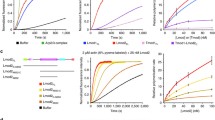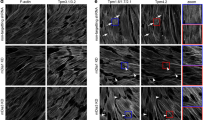Abstract
The assembly of striated muscle myofibrils is a multistep process in which a variety of proteins is involved. One of the first and most important steps in myofibrillogenesis is the arrangement of thin myofilaments into ordered I-Z-I brushes, requiring the coordinated activity of numerous actin binding proteins. The early expression of myopodin prior to sarcomeric α-actinin, as well as its binding to actin, α-actinin and filamin indicate an important role for this protein in actin cytoskeleton remodelling with the precise function of myopodin in this process yet remaining to be resolved. While myopodin was previously described as a protein capable of cross-linking actin filaments into thick bundles upon transient transfections, it has remained unclear whether myopodin alone is capable of bundling actin, or if additional proteins are involved. We have therefore investigated the in vitro actin binding properties of myopodin. High speed cosedimentation assays with skeletal muscle actin confirmed direct binding of myopodin to F-actin and showed that this interaction is mediated by at least two independent actin binding sites, found in all myopodin isoforms identified to date. Furthermore, low-speed cosedimentation assays revealed that not only full length myopodin, but also the fragment containing only the second binding site, bundles microfilaments in the absence of accessory proteins. Ultrastructural analysis demonstrated that this bundling activity resembled that of α-actinin. Biochemical experiments revealed that bundling was not achieved by myopodin’s ability to dimerize, indicating the presence of two individual F-actin binding sites within the second binding segment. Thus full length myopodin contains at least three F-actin binding sites. These data provide further understanding of the mechanisms by which myopodin contributes to actin reorganization during myofibril assembly.





Similar content being viewed by others
References
Asanuma K, Kim K, Oh J, Giardino L, Chabanis S, Faul C, Reiser J, Mundel P (2005) Synaptopodin regulates the actin-bundling activity of alpha-actinin in an isoform-specific manner. J Clin Invest 115:1188–1198
Ausubel FM, Brent R, Kingston RE, Moore DD, Seidman JG, Smith JA, Struhl K (1995) Short protocols in molecular biology. Wiley, New York
Beqqali A, Monshouwer-Kloots J, Monteiro R, Welling M, Bakkers J, Ehler E, Verkleij A, Mummery C, Passier R (2010) CHAP is a newly identified Z-disc protein essential for heart and skeletal muscle function. J Cell Sci 123:1141–1150
Brennan JP, Wait R, Begum S, Bell JR, Dunn MJ, Eaton P (2004) Detection and mapping of widespread intermolecular protein disulfide formation during cardiac oxidative stress using proteomics with diagonal electrophoresis. J Biol Chem 279:41352–41360
Chalovich JM, Schroeter MM (2010) Synaptopodin family of natively unfolded, actin binding proteins: physical properties and potential biological functions. Biophys Rev 2:181–189
Cherepanova O, Orlova A, Galkin VE, van der Ven PFM, Fürst DO, Jin JP, Egelman EH (2006) Xin-repeats and nebulin-like repeats bind to F-actin in a similar manner. J Mol Biol 356:714–723
Claeys KG, van der Ven PFM, Behin A, Stojkovic T, Eymard B, Dubourg O, Laforet P, Faulkner G, Richard P, Vicart P, Romero NB, Stoltenburg G, Udd B, Fardeau M, Voit T, Fürst DO (2009) Differential involvement of sarcomeric proteins in myofibrillar myopathies: a morphological and immunohistochemical study. Acta Neuropathol 117:293–307
De Ganck A, De Corte V, Bruyneel E, Bracke M, Vandekerckhove J, Gettemans J (2009) Down-regulation of myopodin expression reduces invasion and motility of PC-3 prostate cancer cells. Int J Oncol 34:1403–1409
Esteban S, Moya P, Fernandez-Suarez A, Vidaurreta M, Gonzalez-Peramato P, Sanchez-Carbayo M (2012) Diagnostic and prognostic utility of methylation and protein expression patterns of myopodin in colon cancer. Tumour Biol 33:337–346
Faul C, Hüttelmaier S, Oh J, Hachet V, Singer RH, Mundel P (2005) Promotion of importin α-mediated nuclear import by the phosphorylation-dependent binding of cargo protein to 14–3–3. J Cell Biol 169:415–424
Faul C, Dhume A, Schecter AD, Mundel P (2007) Protein kinase A, Ca2+/calmodulin-dependent kinase II, and calcineurin regulate the intracellular trafficking of myopodin between the Z-disc and the nucleus of cardiac myocytes. Mol Cell Biol 27:8215–8227
Geeves MA, Holmes KC (2005) The molecular mechanism of muscle contraction. Adv Protein Chem 71:161–193
Gimona M, Djinović-Carugo K, Kranewitter WJ, Winder SJ (2002) Functional plasticity of CH domains. FEBS Lett 513:98–106
Jin JP, Wang K (1991) Nebulin as a giant actin-binding template protein in skeletal muscle sarcomere. Interaction of actin and cloned human nebulin fragments. FEBS Lett 281:93–96
Jing L, Liu L, Yu YP, Dhir R, Acquafondada M, Landsittel D, Cieply K, Wells A, Luo JH (2004) Expression of myopodin induces suppression of tumor growth and metastasis. Am J Pathol 164:1799–1806
Kolakowski J, Wrzosek A, Dabrowska R (2004) Fesselin is a target protein for calmodulin in a calcium-dependent manner. Biochem Biophys Res Commun 323:1251–1256
Kostyukova A, Maeda K, Yamauchi E, Krieger I, Maeda Y (2000) Domain structure of tropomodulin: distinct properties of the N-terminal and C-terminal halves. Eur J Biochem 267:6470–6475
Kremerskothen J, Plaas C, Kindler S, Frotscher M, Barnekow A (2005) Synaptopodin, a molecule involved in the formation of the dendritic spine apparatus, is a dual actin/alpha-actinin binding protein. J Neurochem 92:597–606
Kruger M, Wright J, Wang K (1991) Nebulin as a length regulator of thin filaments of vertebrate skeletal muscles: correlation of thin filament length, nebulin size, and epitope profile. J Cell Biol 115:97–107
Labeit S, Gibson T, Lakey A, Leonard K, Zeviani M, Knight P, Wardale J, Trinick J (1991) Evidence that nebulin is a protein-ruler in muscle thin filaments. FEBS Lett 282:313–316
Leinweber BD, Fredricksen RS, Hoffman DR, Chalovich JM (1999) Fesselin: a novel synaptopodin-like actin binding protein from muscle tissue. J Muscle Res Cell Motil 20:539–545
Lin F, Yu YP, Woods J, Cieply K, Gooding B, Finkelstein P, Dhir R, Krill D, Becich MJ, Michalopoulos G, Finkelstein S, Luo JH (2001) Myopodin, a synaptopodin homologue, is frequently deleted in invasive prostate cancers. Am J Pathol 159:1603–1612
Linnemann A, van der Ven PFM, Vakeel P, Albinus B, Simonis D, Bendas G, Schenk JA, Micheel B, Kley RA, Fürst DO (2010) The sarcomeric Z-disc component myopodin is a multiadapter protein that interacts with filamin and alpha-actinin. Eur J Cell Biol 89:681–692
Lukoyanova N, VanLoock MS, Orlova A, Galkin VE, Wang K, Egelman EH (2002) Each actin subunit has three nebulin binding sites: implications for steric blocking. Curr Biol 12:383–388
Mundel P, Heid HW, Mundel TM, Kruger M, Reiser J, Kriz W (1997) Synaptopodin: an actin-associated protein in telencephalic dendrites and renal podocytes. J Cell Biol 139:193–204
Obermann WMJ, Gautel M, Weber K, Fürst DO (1997) Molecular structure of the sarcomeric M band: mapping of titin and myosin binding domains in myomesin and the identification of a potential regulatory phosphorylation site in myomesin. EMBO J 16:211–220
Obermann WMJ, van der Ven PFM, Steiner F, Weber K, Fürst DO (1998) Mapping of a myosin-binding domain and a regulatory phosphorylation site in M-protein, a structural protein of the sarcomeric M band. Mol Biol Cell 9:829–840
Pace CN, Vajdos F, Fee L, Grimsley G, Gray T (1995) How to measure and predict the molar absorption coefficient of a protein. Protein Sci 4:2411–2423
Pacholsky D, Vakeel P, Himmel M, Löwe T, Stradal T, Rottner K, Fürst DO, van der Ven PFM (2004) Xin repeats define a novel actin-binding motif. J Cell Sci 117:5257–5268
Perry SV (2001) Vertebrate tropomyosin: distribution, properties and function. J Muscle Res Cell Motil 22:5–49
Pham M, Chalovich JM (2006) Smooth muscle alpha-actinin binds tightly to fesselin and attenuates its activity toward actin polymerization. J Muscle Res Cell Motil 27:45–51
Pittenger MF, Kazzaz JA, Helfman DM (1994) Functional properties of non-muscle tropomyosin isoforms. Curr Opin Cell Biol 6:96–104
Ruppel KM, Spudich JA (1996) Structure–function analysis of the motor domain of myosin. Annu Rev Cell Dev Biol 12:543–573
Sanchez-Carbayo M, Schwarz K, Charytonowicz E, Cordon-Cardo C, Mundel P (2003) Tumor suppressor role for myopodin in bladder cancer: loss of nuclear expression of myopodin is cell-cycle dependent and predicts clinical outcome. Oncogene 22:5298–5305
Schroeter M, Chalovich JM (2004) Ca2+-calmodulin regulates fesselin-induced actin polymerization. Biochemistry 43:13875–13882
Shen X, Valencia CA, Szostak JW, Dong B, Liu R (2005) Scanning the human proteome for calmodulin-binding proteins. Proc Natl Acad Sci USA 102:5969–5974
Sjöblom B, Ylänne J, Djinović-Carugo K (2008) Novel structural insights into F-actin-binding and novel functions of calponin homology domains. Curr Opin Struct Biol 18:702–708
Spudich JA, Watt S (1971) The regulation of rabbit skeletal muscle contraction. I. Biochemical studies of the interaction of the tropomyosin-troponin complex with actin and the proteolytic fragments of myosin. J Biol Chem 246:4866–4871
Stradal T, Kranewitter W, Winder SJ, Gimona M (1998) CH domains revisited. FEBS Lett 431:134–137
Trinick J (1994) Titin and nebulin: protein rulers in muscle? Trends Biochem Sci 19:405–409
van der Ven PFM, Wiesner S, Salmikangas P, Auerbach D, Himmel M, Kempa S, Hayeß K, Pacholsky D, Taivainen A, Schröder R, Carpén O, Fürst DO (2000) Indications for a novel muscular dystrophy pathway. γ-filamin, the muscle-specific filamin isoform, interacts with myotilin. J Cell Biol 151:235–248
Weins A, Schwarz K, Faul C, Barisoni L, Linke WA, Mundel P (2001) Differentiation- and stress-dependent nuclear cytoplasmic redistribution of myopodin, a novel actin-bundling protein. J Cell Biol 155:393–404
Weins A, Schlondorff JS, Nakamura F, Denker BM, Hartwig JH, Stossel TP, Pollak MR (2007) Disease-associated mutant alpha-actinin-4 reveals a mechanism for regulating its F-actin-binding affinity. Proc Natl Acad Sci USA 104:16080–16085
Yu YP, Luo JH (2006) Myopodin-mediated suppression of prostate cancer cell migration involves interaction with zyxin. Cancer Res 66:7414–7419
Yu YP, Luo JH (2011) Phosphorylation and interaction of myopodin by integrin-link kinase lead to suppression of cell growth and motility in prostate cancer cells. Oncogene 30:4855–4863
Acknowledgments
We thank Mrs. U. Kukulies, A. Jünger-Leif, N. Thum-Schmitz, C. Mirschkorsch and Mr. C. Preiss for technical assistance. This work was supported by the German Research foundation: FOR1228 to D.O.F. and FOR 1352 to D.O.F. and K.D.C., and the German Ministry of Education and Research [MD-NET2, 01GM0887 to P.F.M.v.d.V. and D.O.F.].
Author information
Authors and Affiliations
Corresponding author
Electronic supplementary material
Below is the link to the electronic supplementary material.
Rights and permissions
About this article
Cite this article
Linnemann, A., Vakeel, P., Bezerra, E. et al. Myopodin is an F-actin bundling protein with multiple independent actin-binding regions. J Muscle Res Cell Motil 34, 61–69 (2013). https://doi.org/10.1007/s10974-012-9334-5
Received:
Accepted:
Published:
Issue Date:
DOI: https://doi.org/10.1007/s10974-012-9334-5




